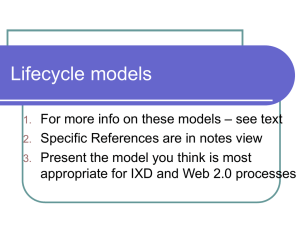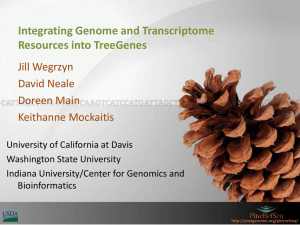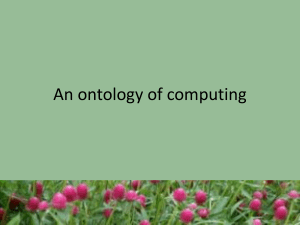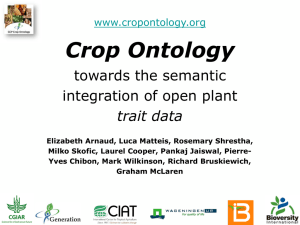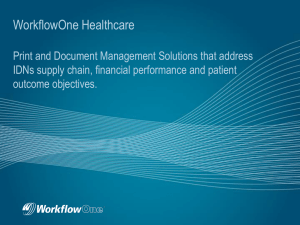Black Box Tests
advertisement
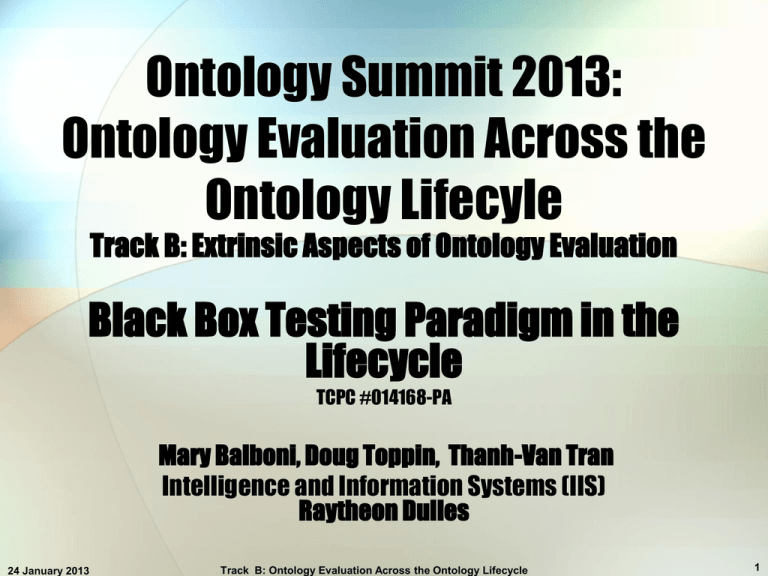
Ontology Summit 2013: Ontology Evaluation Across the Ontology Lifecyle Track B: Extrinsic Aspects of Ontology Evaluation Black Box Testing Paradigm in the Lifecycle TCPC #014168-PA Mary Balboni, Doug Toppin, Thanh-Van Tran Intelligence and Information Systems (IIS) Raytheon Dulles 24 January 2013 Track B: Ontology Evaluation Across the Ontology Lifecycle 1 Black Box Testing Paradigm in the Lifecycle Where does Black Box Testing apply in the Lifecycle? How does it apply to large database systems? How do we validate using Black Box Testing? How well can we measure the completeness and goodness of this testing? Modern Databases and Black Box Behavior / Functionality Testing Some Black Box Tests What are reusable methods that could be used for ontologies? (assuming the paradigm that ontologies exist in the black box similar to how DBs exist in a black box) What are any security concerns? 2 Black Box Testing Paradigm in the Lifecycle White Box Testing aka Structural or Glass Box Testing Verification : are we building the software right? • • • • • Code Modules Statements Branches Paths Conditions Black Box Testing aka Functional or Behavioral Testing Validation : are we building the right software? • Requirements • Functionality • Does it behave as expected in all system conditions 3 Black Box Testing Paradigm in the Lifecycle Where does Black Box Testing apply in the Lifecycle? Customer Environment White Box Black Box Unit Test Functional Integration Acceptance System BETA Ad Hoc Code / Low Level Design 24 January 2013 High Level Design Requirements Track B: Ontology Evaluation Across the Ontology Lifecycle 4 Black Box Testing Paradigm in the Lifecycle How does it apply to large database systems? 24 January 2013 Knowing what data you put in and what the expected results should be Not testing if the database is storing the input in the appropriate tables in the database Database testing is the act of validating the contents, schema, and functionality within a database If caching is involved testing must include cache control/expiration tests Track B: Ontology Evaluation Across the Ontology Lifecycle 5 Black Box Testing Paradigm in the Lifecycle How do we validate using Black Box Testing? Test using a replica of the original database (sandboxes) Create database tests based on either rebuilding the existing database or starting with a new creation of the database and related schema Identify Test Data Develop Tests based on System requirements Once the tests are ready, execute and check the results 24 January 2013 Track B: Ontology Evaluation Across the Ontology Lifecycle 6 Black Box Testing Paradigm in the Lifecycle How do we validate using Black Box Testing? INCLUDE tests for error conditions and degraded mode operations INCLUDE load and capacity testing, this is critical for systems that provide services to a larger enterprise USE HELPFUL TOOL: Facilitated in an SOA environment by tools such as SOAPUI which can discover WSDLs (xml) and provide a test platform If multiple subsystems accessing the database then concurrency and sharing testing should be included 24 January 2013 Track B: Ontology Evaluation Across the Ontology Lifecycle 7 Black Box Testing Paradigm in the Lifecycle How Well Can We Measure the Completeness and Goodness of this Testing? Predicting Latent Defects left in system after system testing is complete (tools like SEER, SWEEP, based on Rayleigh-like curve1) Industry standard is in the range: o 30 to 85 defects per 1K of code during development o ½ to 3 defects per 1K of code latent in the delivered product 1 Metrics and Models in Software Quality Engineering By Stephen H. Kan 24 January 2013 Track B: Ontology Evaluation Across the Ontology Lifecycle 8 Black Box Testing Paradigm in the Lifecycle How Well Can We Measure the Completeness and Goodness of this Testing? Defect Injection / Defect Seeding Technique • How effective are the testers and what kinds of things they miss? • The Process of adding known defects to the existing ones is called Defect Seeding. The Idea is while detecting the known bugs unknown bugs might be detected • Sample Scenario: 1. 2. 3. 4. Go find your friendly local development team Ask them politely to insert 10-100 bugs throughout the code. Test as normal Go back to your friendly local development team and show them what you found 5. Compare lists 6. Ask your friendly local development team to fix all the bugs they inserted before shipping, please. 24 January 2013 Track B: Ontology Evaluation Across the Ontology Lifecycle 9 Black Box Testing Paradigm in the Lifecycle Modern Databases and Black Box Behavior / Functionality Testing 24 January 2013 Modern DBs (NoSQL, document style, Hadoop) may not have established best practices nor has institutional knowledge been developed thus increasing a security risk factor Security related aspects may be dependent on externally configured factors such as access to host/files Track B: Ontology Evaluation Across the Ontology Lifecycle 10 Black Box Testing Paradigm in the Lifecycle Black Box Tests Validate Data Quality by Testing Data Rules • Equivalence Partitioning - Suppose system asks for “a number between 100 and 999 inclusive”. This gives three equivalence classes of input: • less that 100 ; 100 to 999 ; greater than 999 • We thus test the system against characteristic values from each equivalence class. Example: 50 (invalid), 500 (valid), 1500 (invalid). • Boundary Analysis - Arises from the fact that most program fail at input boundaries. Suppose system asks for “a number between 100 and 999 inclusive”. • The boundaries are 100 and 999. We therefore test for values: 99 100 101 Lower Boundary 24 January 2013 998 999 1000 Upper Boundary Track B: Ontology Evaluation Across the Ontology Lifecycle 11 Black Box Testing Paradigm in the Lifecycle Black Box Tests Validate Data Quality by Testing Data Rules • Column Domain – the Flavor column has allowable values of Chocolate, Vanilla, and Strawberry. • Column Default - the default value is Strawberry. • Value Existence – the value of StartDate must be less than EndDate when EndDate is provided • Size Rules - a code in a column must always be two characters in length or a value in a VARCHAR column must be at least five characters in length 24 January 2013 Automated tests can run continuously in the background checking data consistency Track B: Ontology Evaluation Across the Ontology Lifecycle 12 Black Box Testing Paradigm in the Lifecycle Black Box Tests Validate Data Integrity using Create Read Update and Delete (CRUD) logic • C: Create – When user ‘Save’ any new transaction, ‘Create’ operation is performed. • R: Retrieve – When user ‘Search’ or ‘View’ any saved transaction, ‘Retrieve’ operation is performed. • U: Update – when user ‘Edit’ or ‘Modify’ an existing record, the ‘Update’ operation of DB is performed. • D: Delete – when user ‘Remove’ any record from the system, ‘Delete’ operation of DB is performed. 24 January 2013 Track B: Ontology Evaluation Across the Ontology Lifecycle 13 Black Box Testing Paradigm in the Lifecycle Black Box Tests Validate Relationships – Referential Integrity (RI) aka Business Logic (constraints, triggers, procedures) • ‘Referential Integrity’, relational constraints, triggers and stored procedures. So, using these and many other features offered by DBs, developers implement the business logic on DB level. Tester must ensure that the implemented business logic is correct and works accurately. • Would not go into database and check values of triggers, procedures, views or tables – which would be white box texting – but would test by expected results from business logic/rules 24 January 2013 Track B: Ontology Evaluation Across the Ontology Lifecycle 14 Black Box Testing Paradigm in the Lifecycle Black Box Tests Validate Performance Characteristics of Database Access and Object / Relational (O/R) Mapping • User’s actions upon the DB should be executed within needed/required time ranges • Load / Stress Testing – testing under heavy loads, repetition of certain actions, inputs beyond the limits • DB impacts in this area • Configuration of memory and processing resources of the computer running the DB • Impacted by DB maintenance, defrags that increase efficiency in accessing data • Timing of transaction log backups that interrupt database activity 24 January 2013 Track B: Ontology Evaluation Across the Ontology Lifecycle 15 Black Box Testing Paradigm in the Lifecycle Black Box Tests Ensure ACID Properties of Database Transactions • ACID properties of DB Transactions refer to the ‘Atomicity’, ‘Consistency’, ‘Isolation’ and ‘Durability’. Proper testing of these four properties must be done during the DB testing activity. This area demands more rigorous, thorough and keen testing when the database is distributed. • Atomicity: a series of DB operations either All occur or Nothing occurs • Consistency: ensuring that any transaction will bring the DB from one valid state to another, database follows defined rules • Isolation: Ensuring that the concurrent execution of transactions results in a system state that could have been obtained if transactions are executed serially • Durability: once a transaction is committed it will remain so despite crashes, errors or loss of power 24 January 2013 Track B: Ontology Evaluation Across the Ontology Lifecycle 16 Black Box Testing Paradigm in the Lifecycle What are reusable methods that could be used for ontologies? (assuming the paradigm that ontologies exist in the black box similar to how DBs exist in a black box) Defining Requirements for Each of the Following Validating Each of the Following Data Rules Data Referential Integrity Relationships Performance Characteristics Properties of Transactions 24 January 2013 Track B: Ontology Evaluation Across the Ontology Lifecycle 17 Black Box Testing Paradigm in the Lifecycle What are any security concerns? Black Box testing alone is not a suitable alternative for security activities throughout the software development life cycle. Black Box testing is very effective in validating system design assumptions, discovering vulnerabilities and implementation issues that may lead to security vulnerabilities Black box tests can; o help development and security personnel identify implementation errors that were not discovered during code reviews, unit tests, or security white box tests o Discover potential security issues resulting from boundary conditions that were difficult to identify and understand during the design and implementation phases o Uncover security issues resulting from incorrect product builds (e.g., old or missing modules/files) o Detect security issues that arise as a result of interaction with underlying environment (e.g., improper configuration files, unhardened OS and applications) 24 January 2013 Track B: Ontology Evaluation Across the Ontology Lifecycle 18 Black Box Testing Paradigm in the Lifecycle Testing for Security Fuzzing: random character generation – testing by injection random data at the interfaces Syntax testing: tests based on the syntactic spec of an applications input values Exploratory Testing and Fault Injection: useful to perform tests without having specific expectations of outcome – helps spot anomalies Data Analysis: process of trying to understand a program’s internals by examining the data it generates – may go beyond observations and go into influencing the program’s behavior as well = from security POV, test is to see whether an attacker could do the same thing Monitoring Program Behaviour: referred to as Observability – to examine the behavior of the program under test and asking whether this observed behavior is symptomatic of a vulnerability in the system 24 January 2013 Track B: Ontology Evaluation Across the Ontology Lifecycle 19 Bios of Authors Mary Balboni – Over 30 years in engineering, worked through many lifecycles of large systems Doug Toppin – Over 30 years in engineering, with recent experience with large scale backend commercial / industry internet provider Thanh-Van Tran – Over 25 years in Database and software engineering, Certified DBA, experience with large scale database systems 24 January 2013 Track B: Ontology Evaluation Across the Ontology Lifecycle 20

